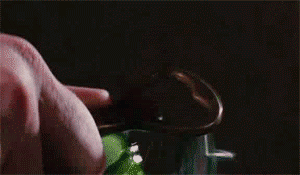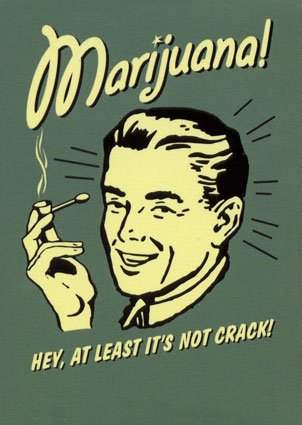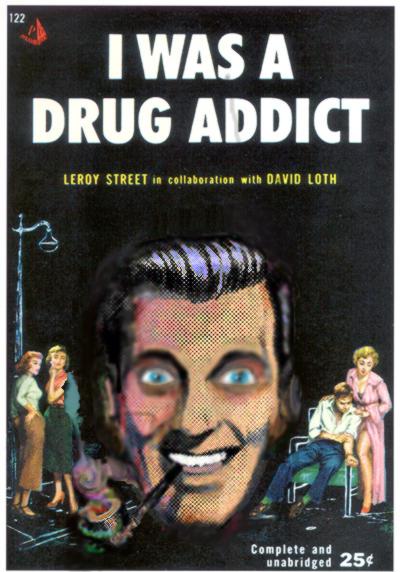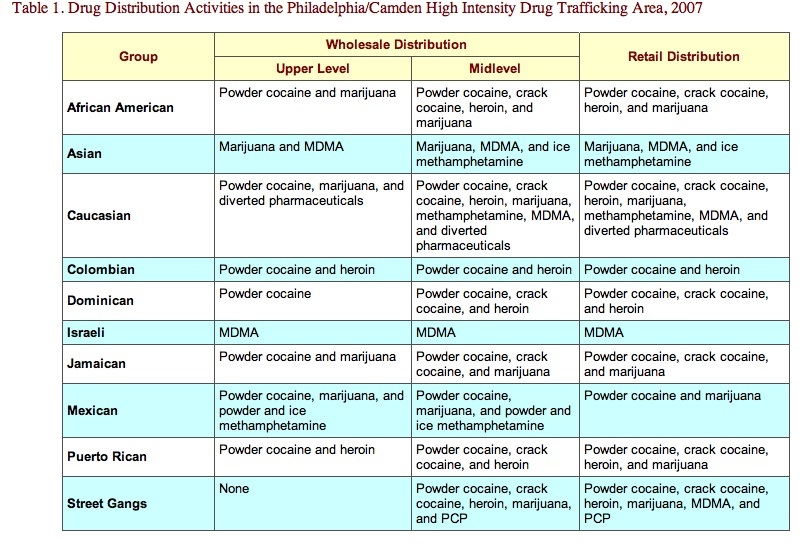 BY JEFF DEENEY MEAN STREETS EDITOR What’s up with drugs? By that I don’t mean, “Dude, who’s holding?” or “which set’s got the bomb bag today?” I’m talking bigger picture stuff. Like, what’s up with drugs, what’s happening in the Philadelphia region? Who are the weight movers and high-level traffickers out there making sure there’s plenty of powder for your nose on a Friday night? This isn’t exactly the kind of information you’re going to come by talking to guys with bad neck tattoos on Kensington Avenue, and anyone who knows and is willing to talk about it probably can’t because their tongue’s hanging out the front of their neck.
BY JEFF DEENEY MEAN STREETS EDITOR What’s up with drugs? By that I don’t mean, “Dude, who’s holding?” or “which set’s got the bomb bag today?” I’m talking bigger picture stuff. Like, what’s up with drugs, what’s happening in the Philadelphia region? Who are the weight movers and high-level traffickers out there making sure there’s plenty of powder for your nose on a Friday night? This isn’t exactly the kind of information you’re going to come by talking to guys with bad neck tattoos on Kensington Avenue, and anyone who knows and is willing to talk about it probably can’t because their tongue’s hanging out the front of their neck.
It’s a good thing then that there’s a drug war raging and the US Department of Justice occasionally needs to get with justifying all that tax payer money they’re spending by releasing fascinating factoid compilations like this Philadelphia/Camden High Intensity Drug Trafficking Area Drug Market Analysis, released in June. This “market analysis” provides a snapshot of the region’s drug trafficking, breaking down the who, what, where and how behind it all. It explains who’s at the top, middle and bottom and any new trends in abuse or distribution. As per usual, I’ll just assume you’re not gonna slog through 17 pages of data analysis on a Friday (dude, it’s almost time to get high!) so I’ve read the document and summarized its findings, adding snappy editorial comments along the way to ease the pain swallowing an otherwise chalky pill.
assume you’re not gonna slog through 17 pages of data analysis on a Friday (dude, it’s almost time to get high!) so I’ve read the document and summarized its findings, adding snappy editorial comments along the way to ease the pain swallowing an otherwise chalky pill.
First, let’s outline exactly what Philadelphia/Camden High Intensity Drug Trafficking Area (henceforth known as the PC HIDTA) is. Per the Department of Justice (DOJ) website:
The PC HIDTA was designated in 1995 to address the threat posed by illegal drugs in Philadelphia County, Pennsylvania (which includes the city of Philadelphia), and Camden County, New Jersey (which includes the city of Camden), and to increase the safety and quality of life of the citizens in the region by measurably reducing drug-related crime and violence.
And boy, are they doing a great job! After 12 years of diligent crime fighting, drug related violence is practically nonexistent. You don’t hear about this stuff in Philadelphia too much because the DOJ’s got shit locked down tight.
Or maybe not. In fact, right in the first paragraph they come out and say that violent crimes, including homicides are on the rise and at their highest point in a decade. Interestingly, the DOJ asserts that the majority of homicides are NOT directly drug-related, though many involved in homicides have drug abuse and/or arrest histories. The primary stated cause of homicides in the PC HIDTA is “interpersonal disputes.”
Mexican drug trafficking organizations (DTOs) are increasing their activity in the region. They supply most of our weed, and also a lot of cocaine. They are making inroads in the area with their factory produced, ultra-high purity, smokeable “ice” brand of meth that is slowly usurping the shitty biker version made in greasy, hair clogged bathtubs in Bristol that you normally get. As you already knew, all that sweet crank goes to “the homosexual male community,” in fact 2/3 of the city’s current supply will probably be in the bathroom at Pure at some point tonight.
The DOJ says the Mexicans also provide transportation services for Colombian and Dominican traffickers that want to bring their drugs across the southern border and then to New York and Philly. Not only that, but Mexican DTOs are even making inroads into Delaware County with their cheap weed and coke; I’m sure that some roofer in Upper Darby who still listens to ’80s thrash metal tapes in his beater pickup truck with no air-conditioning will be totally psyched.
When you talk about wholesale distribution of heroin and cocaine in the HIDTA you’re talking about Colombians and Dominicans moving drugs from South America. Yes, according to the DOJ most of the “horse” trotting into Philly is not coming from Afghanistan or Asia, but South America. Most Colombian DTOs operating in the HIDTA are cells of larger Colombian organizations in New York City. These larger organizations and their cells supply wholesale cocaine and heroin to upper-level distribution groups, primarily Dominicans. Dominicans control midlevel cocaine and heroin distribution in the region and supply African American, Caucasian, Jamaican, and Puerto Rican midlevel and retail distributors. A growing number of Dominican DTOs are bypassing New York sources and obtain cocaine directly from Mexicans at the Southwest Border, lowering costs and increasing profits.
 If you’re still buying ecstasy you’re probably buying off Canadian based Vietnamese dealers, who have unseated the Israelis as the top bringers of warm fuzzies to the dance floor. The Vietnamese are also responsible for introducing high-grade Canadian weed to the area. [Sweet! –The Ed.]
If you’re still buying ecstasy you’re probably buying off Canadian based Vietnamese dealers, who have unseated the Israelis as the top bringers of warm fuzzies to the dance floor. The Vietnamese are also responsible for introducing high-grade Canadian weed to the area. [Sweet! –The Ed.]
Not surprisingly, street level drug trade is controlled by blacks and Latins, with most dealers “poly-dealing” an assortment of substances. Street gangs like the Bloods, Latin Kings, Netas, and Rap Kings control crack distribution. The Bloods are moving to Camden from north Jersey; I had a conversation last night with a guy who just got out of jail in Trenton. He said the Blood/Crip problem there is getting completely out of control and is really scary.
The railways are becoming the preferred method of transporting drugs, currency and gang members back and forth from NYC. In fact, the NJ Transit Northeast Corridor line is unofficially referred to as the “crack line” by law enforcement. Funny, when I lived in NYC I called it the “ghetto train,” or the “screeching baby box,” but that’s only because I was pissed I couldn’t afford Amtrak. Many drug traffickers prefer package delivery services because they can monitor shipments on the Internet. If a shipment is delayed, they assume it was intercepted; they refuse delivery to avoid arrest.
Dominican DTOs supply smaller cities such as Allentown, Bethlehem, Easton, and Reading, and suburban and rural areas, such as Hazleton, Sunbury, and the Pocono Mountains. Dominicans are expanding their distribution activities into these areas because of higher profits that can be generated in smaller cities, where competition is lower.
Retail distribution in Philly typically occurs in open-air markets. Many of these are “owned” by a particular gang or group that sells drugs at that location or collects a percentage of the profits from drug sales conducted by another group. Gangs and criminal groups generally establish ownership of open-air markets through long-term drug sales in an area by taking control through violence or by purchasing the right to sell drugs in a particular open-air market, often at a high price. Retail distributors are becoming more technologically sophisticated; they use cell phones and PDAs to coordinate transactions, making detection more problematic. Sophisticated distributors use prepaid cellular telephones, discontinuing them after short periods, or use prepaid calling cards to thwart law enforcement’s efforts to monitor drug-related communications (OMG, this is just like The Wire!).
PDAs to coordinate transactions, making detection more problematic. Sophisticated distributors use prepaid cellular telephones, discontinuing them after short periods, or use prepaid calling cards to thwart law enforcement’s efforts to monitor drug-related communications (OMG, this is just like The Wire!).
Pharmaceutical drugs are often diverted by abusers through a variety of methods. Abusers, particularly teenagers and young adults, are using the Internet to obtain pharmaceutical drugs. They place orders with online pharmacies or distributors in other parts of the country. They often discuss transactions and place orders on blogs — yes, the DOJ said blogs — and bulletin boards, chat rooms, and through e-mail and electronic messaging. Abusers also steal drugs from pharmacies and family members, doctor shop, and forge scripts. Diverted pharmaceuticals are increasingly abused by young, affluent suburbanites. Welcome aboard the Oxy-Train, Bryn Mawr! Don’t nod out for too long, you might miss your stop and wind up at the end of the line in Kensington.
Cocaine, especially crack, is the primary cause of drug-related deaths, emergency room visits, and rehab admissions in Philadelphia. Heroin abuse is rising; declining heroin purity has contributed to abusers’ injecting greater doses, injecting more frequently, or abusing heroin in combination with other drugs.
The DOJ goes on to explain that diverted methadone sold on the streets by methadone maintenance patients selling their take-homes is a problem (I told you so, 9th Street Methadone guy!). Methadone users are using methadone in combination with benzodiazepines (see also HBO’s “Methadonia”) to increase the high. Benzos are a really big problem in the city, being the second most frequently detected drug after cocaine in drug related deaths. They don’t call ’em Tombstones for nothing, people!
Use of Vicodin and OxyContin is still on the rise according to the DOJ, and they’ve also finally figured out that once addicted to prescription drugs, users often switch to heroin because of its higher availability and lower price. I wrote an article detailing my first hand experience with this phenomenon back in March of 2006.
Here’s a dubious piece of apocrypha that makes me wonder how accurate a lot of this information is:
Diverted pharmaceutical abuse among teenagers and young adults is rising in the region. Such abuse often occurs in social settings such as “pharming parties,” which typically involve teenagers taking medications from their relatives or those prescribed for them, mixing them in a bowl with pharmaceutical drugs obtained by other teenagers, and then ingesting several drugs that they indiscriminately retrieve from the bowl.
Now, this “pharming party” thing, or “bowling” (as I’ve also heard it referred to) is, I think, Snopes-worthy. I got an email out of the blue last year from a producer at “60 Minutes” who wanted to do a show on pharming parties and wanted me to find some kids for her who did this (because I’m an expert on teenage pillheads, I guess). I told her that I was suspicious of the idea; it sounded urban myth-like and in reality could be really dangerous. If this was happening on a large scale there would probably be a lot more dead teenagers associated with it. But I tried; I talked with an undercover narcotics guy I know who handles black market pharmaceutical stuff. He talked to his connections. I talked to Ed Bisch, the Fishtown OxyContin awareness guru who knew a lot of kids on the streets in that neighborhood. Nothing. Nobody could find a credible pharming party story.
I offered the “60 Minutes” woman a more substantial story about users transitioning from OxyContin to heroin, but she didn’t want that. She wanted kids with bowls full of drugs turning up dead. I told her to be careful proceeding with a story like that; there are writers at Reason and Alternet who live to tear flimsy stories like that apart the minute they run. She assured me “60 Minutes” DOES NOT do fluff pieces. Hey, maybe they don’t; the story never aired and that was the last I heard from them.
There’s data-galore still left at the DOJ website, keep reading at The Department of Justice Website.
*
ABOUT THE AUTHOR: Jeff Deeney is a freelance writer who has contributed to the City Paper and the Inquirer. He focuses on issues of urban poverty and drug culture. He is also a caseworker with a nonprofit housing program that serves homeless families.


